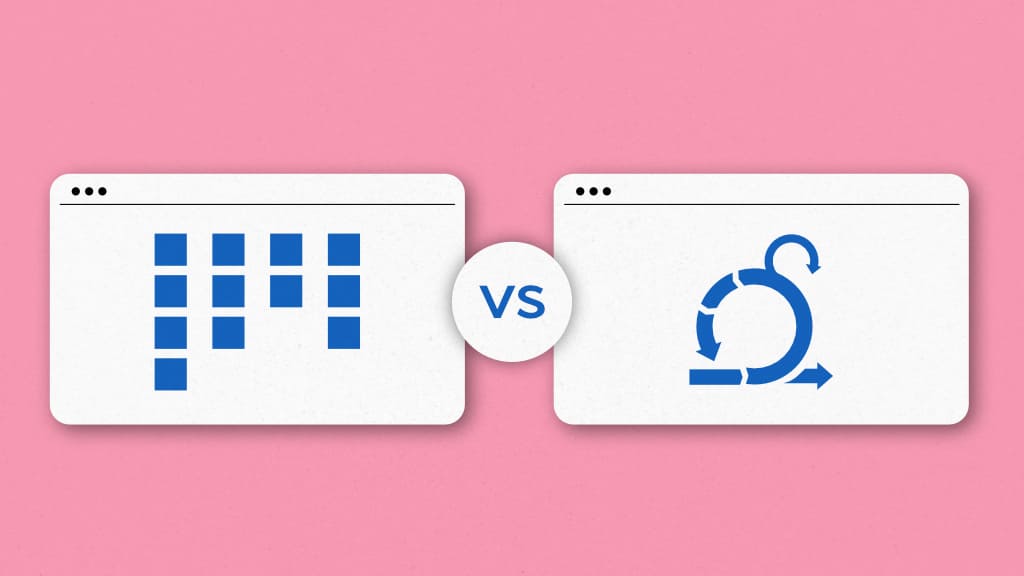Kanban and Scrum are the two most widely used methods within Agile project management – an iterative, adaptive approach that emphasizes collaboration in a project, releasing frequent deliverables, and continuously improving through feedback.
Both frameworks are rooted in the same overarching philosophy of Agile, but differ in processes, practices, and artifacts.
Kanban emphasizes visualizing workflow, limiting work in progress, and optimizing flow using a Kanban board and WIP limits.
Scrum focuses on iterations, feedback, and continuous improvements with time-boxed sprints, structured roles, and Scrum ceremonies.
However, the goal of both is the same—providing adaptability, continuous improvement, and improving speed to market, ensuring customer satisfaction.
That’s why in the Kanban vs Scrum discussion, there is no one universally better. It is more about choosing the right one based on your operating environment, your workflow, the kind of work you’re delivering, and team alignment.
In this post, I will break down Kanban and Scrum, explore key differences between the two, and help you determine which approach is best for your project, business, or team. You’ll understand how they work, where they differ, and most importantly, when to use one over the other (or combine both strategically).
What is Kanban in Agile project management?
Kanban is essentially a method to implement Agile principles and processes. It is a visual workflow management method that focuses on visualizing workflow, limiting work in progress, and optimizing the flow of tasks using a Kanban Board and WIP limits. This framework focuses on balancing the work with available capacity and continuous delivery to make improvements.
For simplification, many professionals refer to Kanban as an Agile framework, but official resources like AgileAlliance and Kanban University refrain from referring to Kanban as an Agile framework or a methodology. They refer to Kanban as a lean method, and it is true. Kanban came into existence as a lean method to facilitate Lean manufacturing in a just-in-time production system developed by Toyota Motor Corporation in Japan in the late 1940s. Kanban is a Japanese term that means “signboard” or “billboard”.
In Agile project management, Kanban is used to implement Agile principles, processes, and frameworks with its own set of artifacts, processes, and practices. Thus, it is referred to as a framework. It uses the principles of both Agile and Lean to manage work better and improve service delivery to meet customer expectations.
Core practices: It defines the practices that guide daily work.
- Visualize the flow of work: Track the tasks from start to finish and visualize how the work progresses.
- Limit work in progress (WIP): Set limits on the number of tasks that can be in progress at once to avoid overload and ensure focus..
- Manage the flow of work: Manage and improve the flow of work across stages to get work done quicker and faster.
- Make explicit process policies: Ensure everyone understands the policies, workflow rules, and definitions of done to build alignment.
- Implement feedback loops: Use regular check-ins like daily meetings to update, sync, and adapt.
- Continuous improvement: Encourage incremental changes to make the process more efficient and evolve workflows.
Defined roles: Kanban does not prescribe fixed roles.
Kanban has no mandatory roles. Instead, leadership is encouraged at all levels to promote a culture where anyone can come up with logical improvement suggestions.
Artifacts: It defines how work is visualized and controlled.
- Kanban board and cards: A Kanban board is a visual board that contains all the tasks to be completed in a project. It contains cards and columns. ‘Cards’ represent tasks, user stories, or features, and ‘Columns’ represent different stages of the workflow, such as To Do, In Progress, Review, Done.
- WIP (Work-In-Progress) limits: WIP limit is a constraint mechanism that defines the maximum number of tasks allowed in each column at any given time. It is set based on the team’s capacity.
Basic principles of the Kanban method:
According to David J Anderson, founder of Kanban University, every successful Kanban implementation has some core properties.
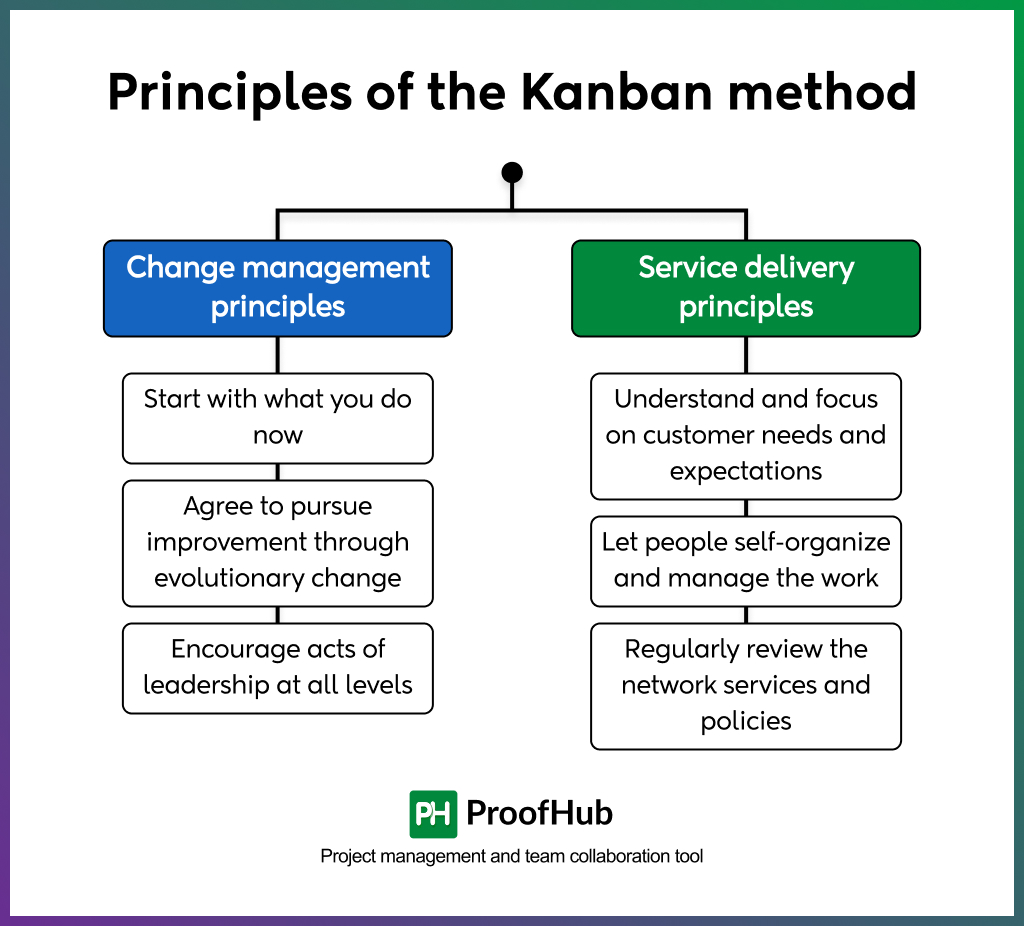
In his book, Kanban: Successful Evolutionary Change for Your Technology Business, he categorizes these principles into two categories:
- Change management principles
- Service delivery principles
1. Change management principles: The introduction of Kanban in your organization requires adherence to three revolutionary change principles.
- Start with what you do now
Begin by evaluating your current roles, responsibilities, job titles, and processes. It is not about reinventing everything, but evolving your current processes gradually and intentionally.
- Agree to pursue improvement through evolutionary change
Kanban emphasizes incremental, evolutionary improvements rather than sweeping, disruptive changes. Because the goal is to promote continuous, small changes that are easy to test, refine, and adopt, without much resistance.
- Encourage acts of leadership at all levels
In Kanban, leadership isn’t restricted to those with titles. Everyone is encouraged to identify inefficiencies, propose improvements, and contribute to process evolution based on rational insight. This requires creating a psychologically safe environment where team members feel empowered to speak up without fear of retribution.
2. Service delivery principles: An organization is an organic identity consisting of a network of services. To improve service delivery, Kanban promotes the following three principles.
- Understand and focus on customer needs and expectations
The prime goal is to deliver outcomes that meet or exceed customer requirements. To achieve this, maintain an open dialogue with customers to understand their needs and ensure the service satisfies their purpose.
- Let people self-organize and manage the work
Empower teams to self-organize around the work to deliver the best value to customers. When we remove the burden of micromanagement and finger-pointing, individuals are more likely to take initiative and deliver quality outcomes.
- Regularly review the network services and policies
There is a correlation between different services, which can be managed by providing feedback at a regular cadence. The regular review of these services and their explicit policies ensures they remain relevant, effective, and aligned with reality.
How does Kanban work?
Kanban is a visual method for managing and visualizing work in Agile project management. It uses a Kanban board and WIP limits. On a Kanban board, each stage is represented as a ‘column’, and tasks are shown as ‘cards’ which are moved across these columns through different stages as the team works on them.
All the work to be done in a project sits in the To-do column, which is the leftmost column in the board. It does not have a Product Backlog as we have in Scrum (discussed later). Work begins when tasks are added in the To-Do column. The team pulls a task from there, works on it, and then delivers it for feedback before moving on to the next task to maintain flow and avoid overload.
The number of work items in any stage is matched to the team’s capacity by WIP limits, which are predefined limits of how many tasks can be in a single column at any one time (except the To Do column).
Tasks are scoped and prioritized upfront, and only those ready for execution appear in the To Do column. As soon as the team has capacity, the next task is pulled in. There’s no need to wait for the end of a sprint as the team members can deliver their respective work items at any time, enabling continuous delivery and a faster response to change.
This enhanced transparency and real-time visibility help teams balance incoming work with actual team capacity, eliminating bottlenecks and ensuring work is always progressing, not stuck or stalled.
To track performance and improve over time, Kanban teams use simple but powerful metrics:
- Cycle Time: The total time it takes to complete a task from the moment it enters ‘In-Progress’ to when it’s marked ‘Done’. It helps improve efficiency.
- Lead Time: The total time from when a request is made (added to To Do) to when it’s delivered.
- Cumulative flow diagrams (CFD): It is a visual tool that charts the number of tasks in each stage of your workflow at any given period along the process timeline.
These metrics help teams spot bottlenecks, identify delays, and make smarter decisions like whether to adjust WIP limits, redistribute work, or simplify a workflow to improve the quality of work.
Benefits of Kanban:
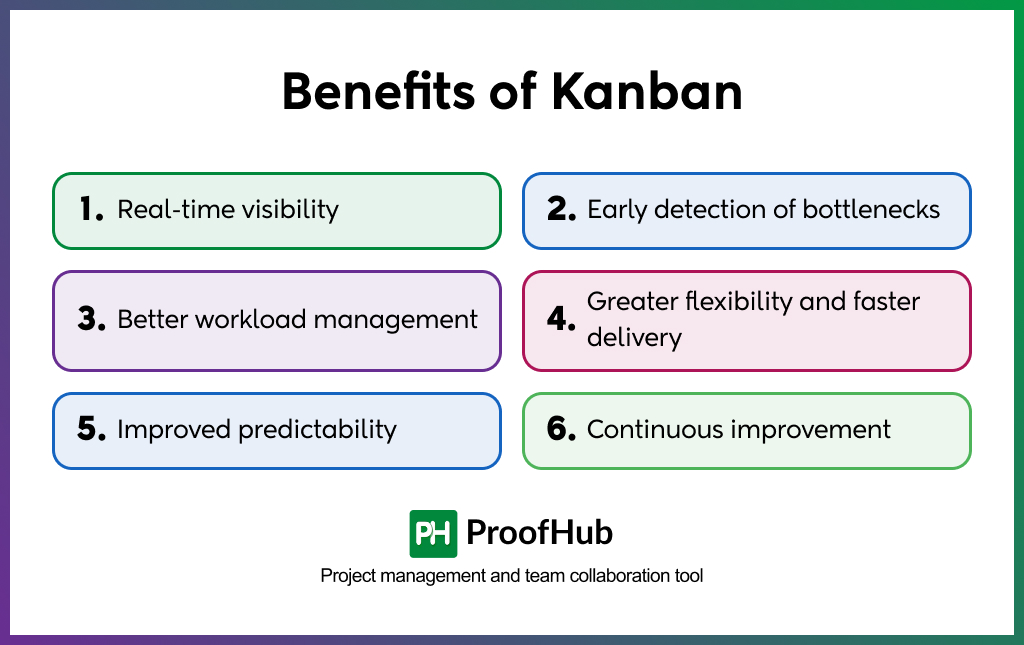
- Real-time visibility: Helps project teams and stakeholders visualize the current state of work at any time.
- Early detection of bottlenecks: Makes it easy to identify blockers, improve ownership, and track progress as it happens.
- Better workload management: WIP limits ensure teams stay focused and avoid overwhelm.
- Greater flexibility and faster delivery: Easily adapts to shifting priorities and helps deliver value faster.
- Improved predictability: Helps teams anticipate challenges, spot patterns, and plan more effectively based on real information.
- Continuous improvement: Encourages a culture of shared responsibility, reflection, and process optimization.
Want to implement Kanban? Explore how ProofHub’s Kanban boards help you manage workflows without much effort.
What is Scrum in Agile project management?
Scrum is an agile project management framework that focuses on breaking the large work into smaller parts and organizing and managing the broken work in fixed-length, iterative cycles called sprints. It focuses on continuous release, feedback, and improvement to deliver customer satisfaction.
Just like Kanban, Scrum had its origins before Agile. It was first introduced in the Harvard Business Review article in 1986, “The New New Product Development Game” by Hirotaka Takeuchi and Ikujiro Nonaka. The name is derived from the sport of rugby, where the ball gets passed between the team members to reach a common goal.
Further popularized by Jeff Sutherland and Ken Schwaber in the early 1990s, they defined Scrum as a framework for teams to develop, deliver, and sustain complex products. They say that for the successful implementation of Scrum, agile teams must embrace five values: commitment, focus, openness, respect, and courage.
Key ceremonies: It defines the events that happen in a sprint.
- Sprint planning: A team meeting where team members decide what to complete in the sprint.
- Daily stand-up: A short daily meeting, also known as a daily scrum, to discuss obstacles and know the latest updates.
- Sprint review: An activity where the completed items are presented to stakeholders for feedback.
- Sprint retrospective: A team reflection session to evaluate what went well and what didn’t to improve upcoming sprints.
Defined roles: It outlines the responsibilities of the Scrum team.
- Product Owner: Responsible for prioritizing tasks in the product backlog.
- Scrum Master: Facilitates collaboration to ensure the team follows Scrum principles without any hurdles and continuous improvement.
- Development Team: A cross-functional, self-organizing group that builds and delivers the deliverables.
Artifacts: It defines work or value to ensure shared transparency
- Product backlog: A prioritized list of requirements, including tasks, features, or user stories.
- Sprint backlog: A subset of the product backlog agreed upon to complete in one sprint by the development team.
- Increment: The usable output or working product delivered at the end of a sprint.
Basic principles of Scrum:
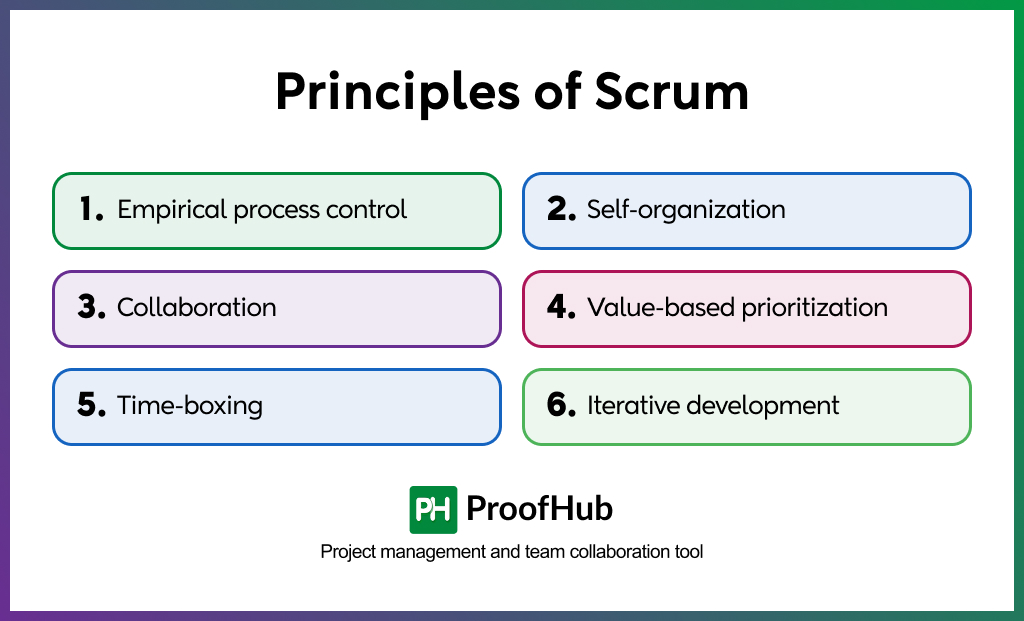
Six non-negotiable principles of Scrum must be adhered to ensure its successful implementation:
- Empirical process control: The core philosophy of Scrum focuses on empiricism, meaning decisions are based on observation and experimentation. It supports three core ideas: transparency, inspection, and adaptation.
- Self-organization: This principle focuses on empowering everyone in the team to self-organize around work. It helps increase buy-in, creativity, and accountability.
- Collaboration: Scrum emphasizes collaborative work at its core, positioning project delivery as a shared value creation process. The three pillars of collaboration are: awareness, articulation, and appropriation.
- Value-based prioritization: This principle encourages teams to prioritize tasks based on the value they provide to customers. It ensures that the team is always focused on delivering maximum business impact.
- Time-boxing: Scrum uses fixed-length iterations called sprints to complete a defined set of tasks. Also, it incorporates time-boxed events such as sprint planning, daily scrum, sprint review, and retrospectives to eliminate time wasters and keep the team focused.
- Iterative development: An entire product is developed in small, manageable increments, so that teams can better manage feedback and changes to continuously improve.
Note: Scrum is also discussed as a methodology because it uses certain tools, processes, and artifacts that are integral to its framework and not found in other approaches.
How does Scrum work?
Scrum is an iterative framework focused on delivering value, continuously learning, and improving through feedback.
In Scrum, all the work starts by forming the Product Backlog, which is a dynamic, prioritized list of features of the product and is owned by the product owner. Before each sprint begins, a sprint planning session is held where items are chosen from the Product backlog based on the team’s capacity to form a Sprint Backlog, a smaller, achievable set of tasks (known as user stories) to be completed in a sprint. The team uses story points to estimate the effort required and decide how much work they can take on in a sprint. The Scrum Master facilitates this session, ensuring teams stay focused on the sprint objectives.
During the sprint, the Development team works collaboratively on the selected tasks to turn them into a working deliverable. Every day, a Daily Stand-up is held to share updates, raise blockers, and align on expectations. The Scrum Master ensures these meetings stay time-boxed and productive.
Each sprint ends with a potentially shippable deliverable (known as an increment). At its end, a Sprint Review is conducted to present this increment for stakeholder feedback. Any changes or improvements are implemented in the next sprints.
This is followed by a Sprint Retrospective, where the team reflects on what went well, what didn’t, and what can be improved in the next sprint. This continuous reflection allows Scrum teams to fine-tune their process and strengthen collaboration for better results.
To measure and improve performance, Scrum teams rely on key metrics:
- Sprint velocity: It is a measurement of the number of estimated story points completed in each sprint.
- Sprint burndown: A visual tool that displays the work remaining in a sprint.
This structured approach helps teams stay focused, deliver value consistently, and adapt quickly to changing priorities.
Benefits of Scrum:
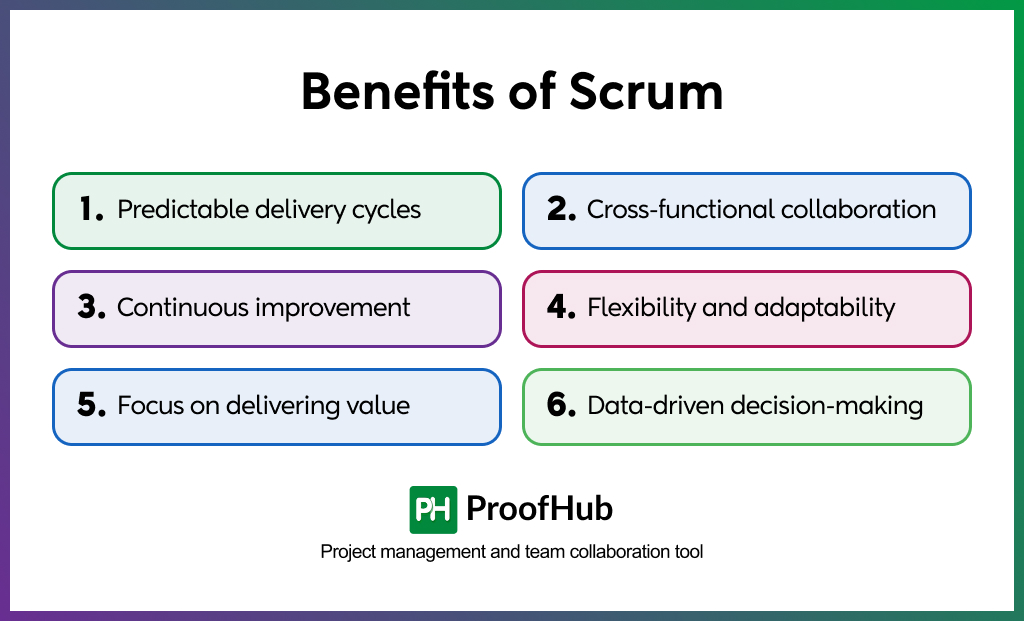
- Predictable delivery cycles: Time-boxed sprints help teams plan and deliver work consistently at regular intervals.
- Cross-functional collaboration: Regular scrum events like daily scrum, sprint reviews, and retrospectives keep everyone aligned.
- Continuous improvement: Retrospectives held at the end of each sprint help the team improve their process over time.
- Flexibility and adaptability: Teams can quickly respond to changing requirements and priorities by reassessing backlog items and adjusting plans.
- Focus on delivering value: Continuous testing, feedback, and incremental delivery ensure teams deliver real value to users.
- Data-driven decision-making: Scrum metrics like velocity and burndown charts give teams insights for better decision-making.
What are the key differences between Kanban and Scrum?
The main difference between Kanban and Scrum is their approach to workflow management. Where Kanban is a flexible, continuous-flow management method that focuses on visualizing tasks, limiting work-in-progress, and optimizing flow, Scrum is a structured, time-boxed framework that divides work into fixed-length sprints, with clearly defined roles, ceremonies, and deliverables.
Here is a side-by-side comparison of Kanban and Scrum:
| Features | Kanban | Scrum |
|---|---|---|
| Ideology | Emphasizes continuous improvement, flexibility, and workflow optimization. | Focuses on delivering value, learning from experiences, and continuously improving through structured iterations. |
| Ceremonies | – Limit WIP – Visualize the workflow – Manage flow – Make process policies explicit – Implement feedback loops – Improve through collaboration Work is based on pull-based systems and regular analysis of flow efficiency. | – Sprint – Sprint planning – Daily stand-up – Sprint review – Sprint retrospective Work is planned and delivered in structured, repeating cycles. |
| Artifacts | – Kanban board – Work items/cards – WIP limits | – Product backlog (Product goal) – Sprint backlog (Sprint goal) – Increment (Definition of done) |
| Roles | No defined roles. Team members share responsibility and collaborate to manage flow as needed. | Defined roles: – Product Owner (defines goals) – Scrum Master (facilitates process) – Dev Team (executes work) |
| Cadence | Continuous flow | Fixed-length sprints (time-boxed) |
| Workflow Board | Continuous board. Columns represent workflow stages, and cards move across them as work progresses. | Sprint-specific board. Displays tasks for the current sprint only. |
| Changes | Highly flexible. Tasks and priorities can change at any time. | Changes during a sprint are strictly discouraged. Teams keep the sprint backlog stable to focus on the final delivery. |
| Planning and Commitment | No upfront planning or formal commitment. Tasks are pulled based on capacity and WIP limits. | Backlog items are planned upfront during sprint planning. Any future commitment is made based on previous sprint performance or team capacity. |
| Delivery Cycle | Continuous delivery (Work items are released whenever they are ready.) | Incremental delivery (A potential shippable product is delivered at the end of each sprint.) |
| Best Application | For projects with ongoing and repetitive tasks | For projects with evolving requirements and priorities |
Kanban vs Scrum: How to choose the right approach for your team?
Evaluating your project is the first step to choosing between Kanban and Scrum. This self-assessment is necessary to identify the framework that can best suit your team’s workflow and business goals.
Below are some suggestions to help you decide:
When should you use Kanban?
Kanban is ideal for projects with continuous and repeatable workflows but require a high level of flexibility, like IT support, content operations, or service requests, where work arrives unpredictably, needs to be tackled in real time, and you cannot wait for the end of the sprint to make changes.
Use a Kanban project management system if:
- Your team needs to adapt to shifting priorities quickly.
- Your team handles ongoing, repetitive tasks.
- Your team delivers frequently and continuously without relying on fixed cycles.
- You prefer efficiency over structure and planning, as Kanban provides real-time visualization of the work implementation
- Your workflow demands adaptability to shifting priorities without disrupting the process.
- Your project doesn’t require rigid accountabilities or defined roles.
- Your goal is to minimize bottlenecks, improve flow efficiency, and deliver frequently.
When should you use Scrum?
Scrum is ideal for complex and evolving projects with a predictable cadence, like software development, product design, or any feature design where work is done in increments, requires frequent feedback and collaboration, and you can wait for the end of the sprint to release the increment in the market.
Use Scrum if:
- Your project requires structured planning, deadlines, and feedback at regular intervals.
- You work on projects with changing requirements, need frequent inspection & approval from stakeholders, and have to make improvisation
- You prefer clearly defined roles like Product Owner, Scrum Master, and Development Team.
- Your team benefits from daily collaboration and focused sprint ceremonies (planning, reviews, retrospectives).
- You like to prioritize work upfront and stick to sprint commitments during execution.
- Your goal is to improve through iteration, respond quickly to change, and continuously deliver value.
| Question | If Yes → Try Kanban | If Yes → Try Scrum |
| Do we deal with frequent change and shifting priorities? | ✅ | ❌ |
| Do we need flexible delivery cycles? | ✅ | ❌ |
| Are team roles clearly defined? | ❌ | ✅ |
| Do we want a flow-based system with minimal process overhead? | ✅ | ❌ |
| Do we want to consider past performances? | ❌ | ✅ |
| Do you need structured meetings (e.g., stand-ups)? | ❌ | ✅ |
Decided on your preferred Agile style? Explore our comprehensive list of agile project management solutions to explore, compare, and choose with clarity.
What is Scrumban? The best of both worlds!
Scrumban is the conjunction of both Kanban and Scrum.
It is a hybrid methodology that combines:
- The structured planning and roles of Scrum, and
- The flow-based flexibility and visual management of Kanban
It forms one powerful, adaptive system that suits the realities of modern work. Because let’s be real, modern project management has evolved to handle unpredictability, shifting priorities, and cross-functional demands.
While Scrum and Kanban are both effective individually, Scrumban brings the best of both worlds, making it a practical choice for teams seeking structure without sacrificing flexibility.
You should consider using scrumban if:
- You need a balance of structure and flexibility.
- You want to optimize your workflow efficiency.
- You are managing complex, fast-moving projects.
- You want to enhance collaboration while staying adaptive.
- You want to transition from Scrum to Kanban (or vice versa).
- You want to improve the way you visualize and manage your work.
Want the best of Scrum + Kanban? With custom workflows and boards, ProofHub lets you blend both seamlessly.
What tools can help in implementing Kanban and Scrum?
Once you have identified the suitable framework for your workflow, choosing the right project management software is the next step to transform your project handling and management.
Here’s my recommendation of the most effective options:
1. Jira
Jira is an issue and project tracking tool ideal for software development teams. Known for its agile team support, Jira supports both Scrum and Kanban to manage complex projects with advanced features like sprint planning, customized workflows, and issue tracking. It’s ideal for larger teams or technical environments that require structured configurations and don’t mind a steeper learning curve.
Looking beyond Jira? Here are better-suited alternatives for modern teams.
2. Wrike
Wrike is a prominent work management solution that helps teams manage complex projects at scale. Known for its enterprise-grade capabilities, Wrike offers features like custom dashboards, workload views, and robust reporting. While its depth is appreciated by many, its clunky user interface, steep learning curve, and high per-user pricing make it less ideal for teams seeking simplicity and faster adoption.
Compare top Wrike alternatives that support Agile workflow without overwhelming you.
3. ProofHub
ProofHub is a powerful agile project management solution for teams that want the simplicity of Kanban, the structure of Scrum, or a custom blend of both, without the steep learning curve. Known for its all-in-one functionality, ProofHub offers advanced features and custom workflows for you to mirror frameworks that suit your style of working. Also, its flat-fee, no-per-user pricing makes it a highly cost-effective solution for growing teams who need agility without blowing the budget.
Looking for something more intuitive, scalable, and budget-friendly?
Try ProofHub, which supports Agile workflows without the complexity of enterprise-level tools or the burden of per-user pricing.
Choose what drives maximum value
Kanban vs Scrum framework is a common debate.
Both frameworks help you apply principles and practices of Agile project management methodology, and while both have proven to deliver results, understanding the strengths and differences of both approaches is crucial to making informed decisions.
Kanban practices visualization to manage workflows, while Scrum imposes structure through defined roles, sprints, and rituals.
Keep in mind, choosing the right project management software along with the right methodology can significantly impact your team’s clarity, speed, and collaboration.
Frequently asked questions
Can you switch methodology from Scrum to Kanban mid-project?
Yes, you can switch from Scrum to Kanban mid-project. However, there may be a short adjustment period for teams to get used to the new workflow.
Here are a few things you should consider before switching:
- Don’t just make the announcement. Loop in your team members on why the switch is being considered.
- Map your current process to a Kanban flow to understand typical flow patterns and delays.
- Redefine how success is measured to focus on flow efficiency, cycle time, and throughput.
- Keep the rituals that work, like daily standups, retrospectives, or planning sessions.
- Start small. Observe how the switch impacts flow, clarity, and morale, then expand Kanban practices.
Can Kanban and Scrum be used together?
Yes, Kanban and Scrum can be used together. And that conjunction is known as Scrumban.
Scrumban is a hybrid methodology that merges the structured planning and roles of Scrum with the flexibility and visual workflow of Kanban. It is often adopted by teams that like parts of both frameworks but don’t want to confine themselves to either of them completely.
What are the similarities between Kanban and Scrum?
As I mentioned earlier, Kanban and Scrum are two frameworks that share core Agile values. Even though they differ in structure, artifacts, and practices, here are the key similarities that bind them:
- Kanban and Scrum both focus on continually improving processes and delivering to customers.
- Both frameworks emphasize transparency, team ownership, and adapting to changes through learning and feedback.
- Collaboration is the foundation of both frameworks, encouraging teams to communicate openly, reflect regularly, and work together toward shared goals.
